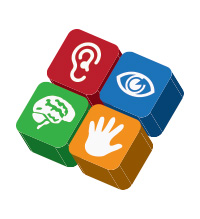 The following information was taken from 3PlayMedia’s 2015 Roadmap to Web Accessibility in Higher Education. Watch upcoming blogs for more information about the types of disabilities and what you can do to address possible access barriers to course content.
The following information was taken from 3PlayMedia’s 2015 Roadmap to Web Accessibility in Higher Education. Watch upcoming blogs for more information about the types of disabilities and what you can do to address possible access barriers to course content.
The term disability applies to a wide range of issues. People affected by a disability face different access barriers and have widely varying needs. Disabilities can be roughly divided into several categories:
Cognitive or Learning Disabilities
A cognitive disability causes a person to have greater difficulty with one or more mental tasks. Most cognitive disabilities have some basis in the biology or physiology of the individual.
Examples: Dyslexia, traumatic brain injuries (TBIs), autism.
Access Barrier: Timed participation may be difficult.
Auditory Disabilities
An auditory disability refers to mild, moderate, severe, or profound hearing loss. Those who refer to themselves as deaf usually have either severe or profound hearing loss. According to study by Johns Hopkins Medicine, more than 48 million people in the U.S. have an auditory disability.
Examples: High noise hearing loss, conductive hearing loss, profound hearing loss, tinnitus.
Access Barrier: Videos may lack captions.
Visual Disabilities
Visual impairment affects a large number of people, including those who use glasses or contacts to correct vision. Blindness, or a complete lack of vision, is at the extreme end of the scale.
Examples: Low vision, color blindness, legal blindness.
Access Barrier: Web sites and electronic documents may not be accessible by keyboard. Videos may lack audio descriptions.
Motor Disabilities
A motor disability can limit a person’s mobility, making it hard for the individual to operate hardware in the way that it was designed.
Examples: Arthritis, muscular dystrophy, spinal cord injury.
Access Barrier: Web sites with user interfaces that require precise control (e.g. small buttons).
Invisible Disabilities
An invisible disability is a disorder not outwardly noticeable that impacts an individual’s ability to perform daily activities like work or school, socializing, or even self-care. Invisible disabilities can include social or psychological challenges, such as anxiety. Depression, bipolar disorder, autoimmune disorders, allergies, and Lyme disease are all examples of invisible disabilities. People with invisible disabilities may require different levels of support on different days.
PTSD, or post-traumatic stress disorder, and traumatic brain injury (TBI) are also examples of invisible disabilities. Many returning soldiers struggle with these conditions, which can impact their ability to retain information. As such, veterans enrolled in classes may need more time completing assignments. Nearly 7,000 universities are eligible to educate soldiers and veterans through the G.I. Bill. With the number of veterans drawing educational benefits soaring to 555,329 in 2011, institutions of higher learning must be prepared for the unique challenges of their veteran students.

